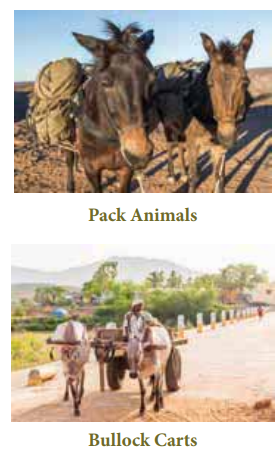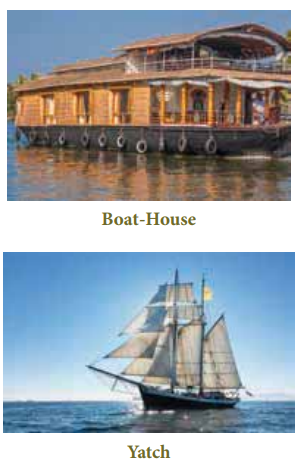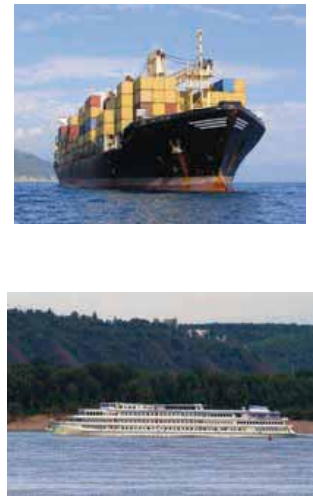Chapter: 11th Commerce : Chapter 14 : Transportation
Types of Transport
Types of Transport
Transport system can be classified in
different ways depending on the types of transport, the ways and means of
transport and also the motive power used in transport.
A. Surface Transport
B. Water Transport
C. Air Transport
A. Surface Transport
Transport of people and goods by land vehicles is known as Surface transport. It is also called as ‘Land Transport’.
1. Pack Animals
Animals like horse, mule, donkey camel, and elephant etc., are used for carrying small loads in backward areas, hilly tracks, forest regions and deserts known as pack animals. Generally, the pack animals serve areas which are inaccessible to modern means of transport. Animal transport has also played a significant role where there is no road and railway transport.

2. Bullock Carts
It constitutes the predominant form of rural road transport in India for goods traffic and to some extent for passengers’ traffic. It links up the villages with the nearby markets and railway stations. It carries the produce for sale to the market and consumer goods to the villages.
3. Road Transport
Road Transport is one of the most promising and potent means suitable for short and medium distances. It provides the basic infrastructure for bringing the majority of the people who are living in far-off villages into the mainstream of nation like by connecting them to different places. It offers a number of advantages such as flexibility, reliability, speed and door-to-door service, besides supplementing and increasing the efficiency of the other modes of transport.
4. Motor Lorries and Buses
From the dawn of civilization, people have been endeavoring to form roads and use wheeled vehicles to facilitate transport of men and materials. The credit of revolutionizing the road transport and introducing the elements of speed and greatercarryingcapacityintothesystemgoes to motor lorries and buses. Introduction of petrol engine and later diesel engine vehicle has been offering good competition to the railways.
5. Tramways
It made their appearance in the 19th century as a form of transport suitable for big cities. Tramways were initially horse drawn later steam-powered and now electrically operated. Its carrying capacity is large. They are able to cope up with the peak hour traffic in big cities with the greater popularity of motor buses, tramways slowly declined. Madras city had tramways till 1933.

6. Railway Transport
The invention of steam engine by James Watt, revolutionized the mode of transport all over the world. Railway, as a mode of transport is the most organized transport undertaking all over the world. Railways are the cheapest and quickest means of transport for carrying heavy goods over long distance.
Railways render an essential public service. It requires a huge capital outlay for laying of tracks, construction of bridges, purchase of locomotives etc. Railways are among the biggest public utilities of a country.
Rail transport is a means of transferring of passengers and goods on wheeled vehicles running on rails (tracks). Rail transport stated to be important in the Industrial Revolution.
There are three types of tracks that are in operation. They are (I) Meter gauge (ii) Broad gauge and (iii) Narrow gauge
B. Water Transport
“Water is a free gift of nature’. Human civilization through gradual application of science and technology, have utilized water resources for economic, political and military activities. Remarkable advancements are taking place in water transport due to considerable improvement in the construction, design motive power, speed and safety of ships and boats.
Water transport is the process of moving people, goods etc. by barge, boat, ship or sailboat over a sea, ocean, lake, canal, river, etc. This category does not include articles on the transport of water for the purpose of consuming the water. Water Transports are of two types
(i) Inland Waterways ii). Ocean Waterways
i. Inland Waterways
Inland Waterways comprise of rivers, canals and lakes. It is also known as internal water transport. Rivers that are naturally navigable are called natural waterways. Canals and canalized rivers belong to the category of ‘Artificial Waterways’. Generally small boats and steamers are operated on rivers to transport people and goods. Where rivers are deep enough, large ships can also ply on them. Canals are man- made waterways, constructed for the twin purposes of navigation and irrigation.

Advantages of inland waterways
· It is considered as the cheapest mode of transport among the other modes of transport.
· It carries goods smoothly due to the absence of shaking and jolting during transit. It is eminently suitable for the carriage of fragile goods like glassware, earth ware etc., without causing damage.
· It is most suitable for heavy loads.
· There is lesser pollution in water transport.
· Initial investment on river services as well as expenditure on their maintenance is much lesser as compared to road and rail transport.
Disadvantages of inland waterways
· It is the slowest means of transport. As compared to this, railways are quicker, safer and cheaper means of transport.
· Floods caused during rainy season, lack of flow of water during summer season affect to ply boats and steamers.
· Sometimes rivers also change their way. It leads to stoppage and uncertainty in usage of this means of transport.
ii. Ocean or Sea Transport
Ocean transport has been playing a significant role in development of economic, social and cultural relations among countries of the world. International trade owes its growth to ocean transport. Ocean transport enjoys a pride of place in aiding international trade. Cheapness is its great virtue. In the transportation of low-grade, bulky goods among the countries, the role of ocean transport is commendable.
Types of Ocean Transport
Ocean transport may be divided into two broad categories.
a. Coastal shipping
Coastal shipping constitutes an important means of transport in all countries having a long coastline. It is a cheap means of transport for the movement of bulky cargoes like coal, iron ore etc. to domestic ports of country. Usually, coastal shipping

b. Overseas shipping
It means the passengers’ and goods have to cross ocean. Example India export goods to America.
Ocean going ships may also be divided into two, namely Liners and Tramps:
i. Liner
An ocean liner is a passenger ship primarily used as a form of transportation across seas or oceans. Liners may also carry cargo or mail, and may sometimes be used for other purposes (e.g., for pleasure cruises or as hospitals ship). They sail to schedule, whether they have a full load or not. They follow defined routes with fixed places and times of call. Regularity of service, god sped and luxurious facilities to passengers are the specialties of liners.
There are two types of liners, namely, Passenger liners and Cargo liners.
ii. Tramps
Tramps are essentially cargo vessels. See the picture above. They have no set routes. They do not follow any timetable. They sail only when they get sufficient load. They sail at any time and carry cargoes for almost any ports.
The following is the major types of commercial ships
1. General cargo ship 2. Bulk carriers 3. Container ships 4. Auto carrier 5. Tankers
6. Fishing vessels 7. Oil vessels 8. Passengers ships 9. Ferryboats 10. Tow and tug boats
11. Specialized ships
C. Air Transport
Air transport is the fastest and the
costliest mode of transport. Commercial air transport is now one of the most
prominent modes of overseas transport.The modern air transport has its growth
with the invention of Airplane by Wright Brothers.

Air transport is a form of travel in vehicles such as helicopters, hot air balloons, blimps, gliders, hang gliding, parachuting, airplanes, jets or anything else that can sustain flight.
Domestic and Internationa flights
Air travel can be grouped into two
general classifications: national/domestic and international flights. Flights
from one point to another within the same country are called domestic flights.
Flights from a point in one country to a point of different country are known
as international flights. Travelers can use domestic or international flights
in either private or public travel.
Advantages of Air Transport
·
It provides a regular, convenient,
efficient and quick service.
·
Perishable goods like fruits,
vegetables, egg, meat, etc., can be transported quickly.
·
It does not require huge investment for
construction and maintenance of track like railways.
·
They provide comfortable services for
passengers and safety for their goods.
·
It can be used to move goods to areas,
which are inaccessible to other means of transport.
·
It is very much helpful for flood or landslide
and war rises to the occasion to save human life from danger.
Disadvantages of Air Transport
·
It is a very costly mode of transport.
The rates and fares charged by which are beyond the reach of common people.
·
Air craft are not quite suitable for
carrying heavy loads and weights.
·
It is not dependable because of
unfavourable weather which may disturb the air service suddenly.
·
The
construction and maintenance of aerodromes involve a huge
capital expenditure.
·
Everycountrycontrolstheairspaceabove its
territory. Therefore, an aeroplane cannot fly over another country without
obtaining its prior permission to concern authority.
Related Topics